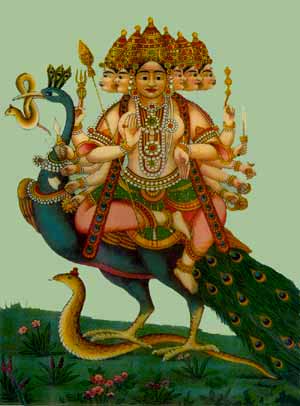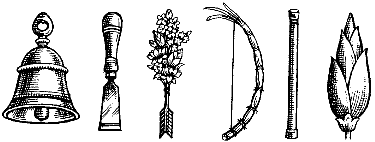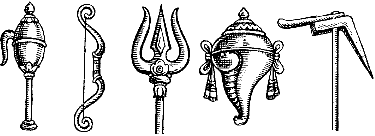
|
|||||||||
|
| |||||||||
Karttikeya in the folk life of Orissa
Kailash PattanaikSkanda-Murukan is known as Kārtika or Kārttikeya among the folk of Orissa. In every culture deities have direct and deep impact on the folk. Cultures, where there are no tradition of idol worship, even there, we can observed that people are guided by the will of the Supreme Being as interpreted by the priests. Impact of religious belief is always deep in every culture irrespective of idol worship or devoid of it. The socio-culture life pattern of particular group of people identified under a particular language and geographical area, are united mainly through the philosophical doctrine of a specific religion or sometimes even through a particular object of worship. One can early establish this fact by analyzing any culture. Geographically Orissa is close to southern India to a great extent. It has a long historical relation with neighboring Andhra Pradesh. Some historians traced the supremacy of Andhra Pradesh over Orissa up to 3rd century A.D. By 1484 AD King Purusottama Deva of Orissa from Surya dynasty conquered the Bahamani Kingdom, regaining his lost territory in the southern part of Orissa including Rajamundri and Kondavidu. King Krishna Deva Raya of Andhra Pradesh fought for seven years against the King of Orissa, Prataprudra Deva, and at the end they made a treaty in 1519 AD and demarcated River Krishna as their boundary. So historically Orissa has an eventful relation with its southern neighbor. The cultural interaction of both sides can be traced through their common art and sculpture, religion and philosophy. Yet it is surprising that Karttikeya, who is one of the most significant deities of southern India, does not figure prominently at the surface level of Orissa's cultural and religious life.
In Orissan folk life, Karttikeya is not as popular a deity as Śiva, Parvati, Visnu or Mangala et al. He is not a god who is worshiped in day-to-day life regularly. Yet he plays a specific role in the life of the folk of Orissa, which is not at all negligible, and which forms the focus of this study. The population of Orissa consists mostly of Hindus. Though they worship almost all the Hindu deities, and although Orissa is called the Land of Temples, interestingly there is no shrine exclusively meant for Karttikeya. So at the surface level of the socio-cultural life of Orissa, the significance of Karttikeya is not obvious, but can be traced out at the deeper level. In Indian society, folk beliefs are mainly centered around a particular deity or object of worship. People worship specific gods in specific situations and for specific problems. For instance, if they want rain they worship one deity, while for harvest they worship another deity. Likewise, in Orissa, if someone is not blessed with a child, especially a son, then he or she takes refuge in Karttikeya. As far as this particular problem is concerned, Karttikeya's supremacy is above dispute. Mainly for this reason, Karttikeya plays an important role in Orissan cultural-religious life without even having a separate shrine of his own! The worship of Karttikeya varies to some extent from region to region in the state. The main procedure is as follows in the Puri District. A childless couple or a couple who wishes to have a son should keep penance until the end of the ritual. At the beginning the priest invokes god Karttikeya through hymns and starts offering oblations. The couple offers flowers to supplicate the god to fulfill their desire. In the following days only the priest worships the deity and dedicates offerings. There is no specification in offerings. It depends solely upon the economical condition of the couple. Usually people offer various types of homemade rice and wheat cakes, sweets, fruits etc. The worship continues for seven days, usually starting from the tenth day of the bright fortnight until the first day of the dark fortnight during the seventh month, namely Kārttika or Tula. In the northern part of Orissa, particularly in the coastal district of Balasore, the procedure is completely different from that of Puri District. In this region the ritual is performed only for one day, namely on the first day of the month of Brushchika, known as Margasira. But here again the purpose of worship is the same: to get a male offspring. The worship continues for the whole night. Traditionally each day is divided in to eight prahāras (quarters), so a single night consists of four prahāras. Worship for one whole night means for four prahāras. It starts in the evening and ends towards dawn. In each prahāra the priest performs a separate homa (oblation) and during each oblation either the couple or only the husband have to take bath before taking part in the ritual. For the performance of the ritual, four knives, different kinds of toys, and soil from four specific places are indispensable. All these items are full of significance. As Karttikeya is considered as the commander-in-chief of the divine army, knives represents his weapons. As he grants boon for getting a child the toys symbolizes children. The ritual collection of soil is also rich in symbolic associations. The soil has to be collected from four different places and each place has certain traits. Some soil should be collected from a place where a bull has rubbed its horn, representing vigor. Other soil is collected from the doorstep of a prostitute, representing Lakshmi. There is a popular belief among the folk of Orissa that the goddess of wealth Lakshmi casts him away who visits a prostitute. So when he enters the house of a prostitute, Lakshmi stay behind and remains at the doorstep of the prostitute. Collecting soil from the doorstep of a prostitute means bringing Lakshmi home. Indirectly it means that worship of Karttikeya brings wealth to the house. Thirdly, soil collected from a crossroads represents conjugal union. Lastly soil from a riverbank symbolizes fertility. Apart from these three materials, germinated paddy is also very essential for the ritual, which again symbolizes the prospect of pregnancy. Apart from these aspects, Karttikeya is also adored among Orissan folk for another important reason. This reason is a very popular one, more popular then the above mentioned one. Unmarried Orissan girls worship Karttikeya for obtaining a husband as handsome and vigorous as Karttikeya himself. This ritual taken place during the month of Kanya, that is Aswina. The full moon night of Aswina, which follows Dassera, is popularly known as Kumāra Pūrnami throughout the state. Here Kumāra denotes Skanda or Karttikeya. This full moon night is also known as Kojagari Purnima when some people worship Gaja Lakshmi. But throughout the state, people irrespective of village or town celebrate Kumāra Pūrnima not only by worshipping Karttikeya, but also with much festivity and merry-making. Significantly, unmarried girls worship the full moon as god Karttikeya. This ritual also varies from place to place. In some locality girls keep fast for the whole day. But the fasting is not strict. The girl keeping the penance should not take rice or any cooked food until the end of the ritual. But in the night, after the end of the performance, she can have vegetarian food. In the daytime she can take fruits, sweets, milk, curd, etc. But in some localities girls keep penance for an entire month, starting from Janhi Osha in the month of Bhadrava up to Kumāra Pūrnima in the month of Aswina. The duration is from one full moon night to another full moon night. But whether the penance is for one day or one month, it always ends in the full moon night of Aswina, i.e. in Kumāra Pūrnima. The ritual of worship starts early in the evening of the Kumāra Pūrnima just as the moon rises. If the puja starts late then it is popularly believed that the girl who is keeping the penance will get an aged groom instead of a young one. Usually the ritual taken place near a tulsi plant. Sometimes people plant a new tulsi in a convenient place where they can instantly see the moon while it is rising. Two things are indispensable for the puja; those are white water lily and laja (puffed paddy). For offerings, different kinds of sweets, home made rice and wheat cakes, and fruits are needed. At the end of the puja girls hold laja in their folded hands and offer anjali to the moon seven times. The puja may be performed individually or in a group. Sometimes girls from all over the neighborhood assemble together to perform the puja. A priest is not essential for the puja. After the ritual ends people distribute prasada among the neighbors. The girls visit each other's houses in the moonlit night. Usually they sing songs in groups. Sometimes a group of girls from one neighboring area assembles together to engage in singing competition with another group of girls from a neighboring area. They reply to each other in song only and everything is only for merrymaking and fun. All the unmarried girls, sometime even unmarried boys, wear new cloths on this day. From the analysis of both rituals one notices that the second ritual is more popular and observed throughout the state than the first ritual, which is observed by a few. The second one is more folk-oriented and simple in nature. Almost all the womenfolk of the family, sometimes even the male members, help the girls during puja. But in both cases, the deity has a direct involvement with the devotees. Devotees worship the god to get a boon for fulfillment of his or her desire. Besides these two examples, the indirect involvement of Karttikeya can be observed. The seventh month of the year is known as Karttika, which is named after the nakshatra Karttik, personified as the foster mothers of Karttikeya. From religious point if view, the month of Karttik is very important in the state of Orissa as it is generally considered as a holy month. During this month, almost all widows, old people and even some people irrespective of age and sex abstain from non-vegetarian food. People who cannot take vegetarian food for the whole month can observe it by taking non-vegetarian food only during the last five days of the month, known as pañcaka. Usually the calculation of the month for the penance starts from the previously mentioned Kumara Purnima until the full moon day of Karttika. People who believe in the ritual usually have to take bath early in the morning either for the whole month or for the last five days before full moon. After bath they usually visit a temple or temples and devote their time to religious activities. Mahadeva Dasa, an 18th century poet of Orissa, wrote a work called Kārttika Mahātmya which glorifies the importance of the month in a grand way. Usually people read or listen to this book during the month. Usually people read or listen to this book during the month. But the most important purana, which is read or listened almost in all households, is Srimad Bhagava by Jagannatha Dasa, a sixteenth century saint poet of Orissa. Early in the full moon day of Karttik, people take a bath before dawn and visit temples. Usually they either go to a river or a pond for the holy bath. It is proper to mention here that this full moon day of Karttika is also observed as the remembrance day of Orissa's glory of its maritime traditions, and people sail boats made out of banana leaf in the sea, river or in pond with flowers and lighted lamp. There are a number of origin myths in Indian folklore. In almost every case we can trace a god or a goddess behind the myth. There is a myth that explains how the trees kimsuka, peepal and banyan originated. This myth focuses upon the creation of Karttikeya indirectly. The myth is found in Mahadevi Dasa's Kārttika Mahātmya. The myth is as follows: During the time of conjugal meeting of Lord Śiva and Parvati, gods in the heaven learned that the son, who would born out of this meeting, would be a mighty one and would be invincible. He would conquer Triloka: pruthibe (the earth), swarga (the heavens), and patala (the lower realms); he would make all other gods his subordinates. Out of this anxiety the gods wanted to interrupt the union of Śiva and Parvati. So they prayed to BrahmĀ and Vishnu to do the needful. Both BrahmĀ and Vishnu went to the place of Śiva and Parvati and uttered the sacred mantra Om. As a result Śiva became conscious and out of shame he ran away. The whole incident not only upset Parvati; it also raised her anger. She cursed BrahmĀ, Vishnu and Śiva to be immovable. Immediately the three of them were transformed into the trees kimsuka, peepal and banyan respectively. This origin myth has little to do with Karttikeya directly, but the incident plays a greater role in the genesis of Karttikeya. Because of this incident Karttikeya originated outside his mother's womb. Earlier it was mentioned that, though there is no temple exclusively for Karttikeya, he is worshipped in many temples as a parsva devatā or secondary god, his influence on the folk life of Orissa is specific yet significant. Dr. Kailash Pattanaik is a Reader in the Department of Oriya at Visva-Bharati University, Shantiniketan, West Bengal. He has written a number of books and scholarly articles on folklore and Oriya literature.
Index of research articles on Skanda-Murukan |



